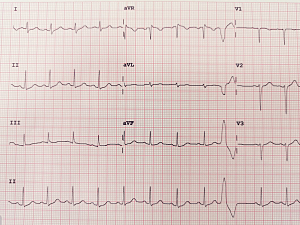In Circulation, the American Heart Association, American College of Cardiology Foundation and Heart Rhythm Society published joint guidelines for noninvasively identifying patients at risk of sudden cardiac death, stating that high-grade ventricular ectopy during recovery from exercise treadmill testing suggests mortality risk in patients with and without heart failure or coronary artery diseases.
However, the participants in the studies cited in support of this statement either had documented disease or were referred to testing for clinical indications. Whether premature ventricular contractions (PVCs) during exercise stress testing have important prognostic implications for asymptomatic individuals is under debate.
In the first study of its kind, researchers at Brigham and Women’s Hospital investigated the prognostic value of PVCs in asymptomatic individuals not suspected of having heart disease. High-grade PVCs that occurred during recovery from stress testing, but not those that occurred during exercise, were associated with long-term cardiovascular mortality independent of clinical and exercise test variables.
Samia Mora, MD, MHS, director of the Center for Lipid Metabolomics in the Divisions of Preventive Medicine and Cardiovascular Medicine at the Brigham, and colleagues detail their findings in the Journal of the American College of Cardiology.
Methods
The researchers analyzed data from the Lipid Research Clinics Prevalence Study, a prospective cohort of individuals enrolled at 10 primary care centers in North America between 1972 and 1976. Of 13,852 individuals who had screening exercise testing at baseline, 5,486 were asymptomatic. The mean follow-up was 20 years, and the study ended in December 1995.
42% of participants were female, the mean age at baseline was 45, and 50% of individuals had hyperlipidemia (the cohort was enriched for the latter).
High-grade PVCs were defined as those that were frequent (>10 per minute), multifocal or R-on-T, or occurred as two or more together (including ventricular tachycardia).
Results
High-grade PVCs occurred in 1.8% of participants during exercise, 2.4% during recovery from exercise and 0.8% during both exercise and recovery. There were 840 deaths (15%) due to any cause, including 311 deaths related to cardiovascular disease (37% of deaths).
High-grade PVCs and Mortality
After adjusting for age and sex:
- High-grade PVCs during the recovery phase were associated with cardiovascular mortality (adjusted HR (aHR), 1.59; P=0.015)
- High-grade PVCs during exercise were not significantly associated
The relationships did not change much when the researchers additionally adjusted for numerous clinical and exercise test variables:
- High-grade PVCs during recovery were associated with cardiovascular mortality (aHR, 1.34; P=0.020)
- High-grade PVCs during exercise were not significantly associated
- Participants who had high-grade PVCs during either exercise or recovery were at increased risk of cardiovascular mortality (aHR, 1.63; P=0.015); this result was driven by the risk associated with recovery PVCs
High-grade PVCs during recovery predicted cardiovascular mortality in both men and women, both smokers and nonsmokers, and regardless of the presence of diabetes, hyperlipidemia or hypertension.
Clinical Implications
Adding the exercise-induced PVC data to a comprehensive set of other variables did not improve risk stratification in this cohort. However, such information could be useful at the individual patient level. Clinicians who note high-grade PVCs during recovery would be alerted to schedule more frequent follow-ups and intensify efforts to reduce the risks of cardiovascular disease.
